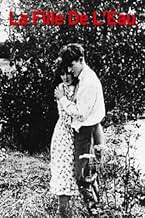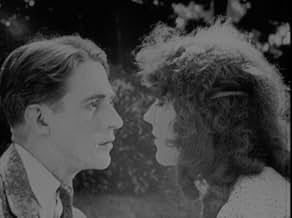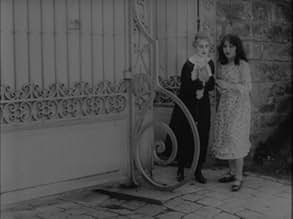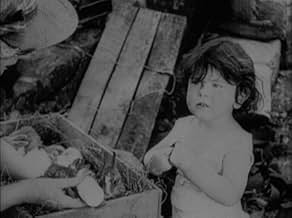CALIFICACIÓN DE IMDb
6.7/10
748
TU CALIFICACIÓN
Tras la muerte de su padre y tras haberse bebido su tío toda la herencia, Virginia se queda sola. Es aceptada por una familia de bohemios, pero una disputa entre los bohemios y los campesino... Leer todoTras la muerte de su padre y tras haberse bebido su tío toda la herencia, Virginia se queda sola. Es aceptada por una familia de bohemios, pero una disputa entre los bohemios y los campesinos la obliga a huir de la revuelta.Tras la muerte de su padre y tras haberse bebido su tío toda la herencia, Virginia se queda sola. Es aceptada por una familia de bohemios, pero una disputa entre los bohemios y los campesinos la obliga a huir de la revuelta.
- Dirección
- Guionista
- Elenco
- Dirección
- Guionista
- Todo el elenco y el equipo
- Producción, taquilla y más en IMDbPro
Opiniones destacadas
This will mostly seem outdated now. A silent melodrama about a young destitute girl in the French countryside trapped between men who desire her, and on the other hand by her efforts to comply or reciprocate. Various bargains that have to do with money as the more or less thinly veiled metaphor for sex.
But there is a dream sequence here that, as so often with these silent dreams, I urge you to see. It's about the girl transmuting in her feverish mind these barely comprehensible forces that threaten the virgin soul into images that will make sense; so an imaginative flight, a sensual, delirius game of hide-and-seek where the coarse, violent men haunt her down, where a piece of rope transforms into the snake of mischievous desire, a point-of-view rushing towards a door and the light outside, and finally the man who can protect her shown, quite literally, as a champion on his white horse galloping across the skies.
The overwhelming experience is so perfectly about the distorted imprint of the world. This should be seen next to the best moments in Epstein. There is shadow here cast by the eye in motion, emotional or otherwise.
Another note that intrigues, a blemish in the perfect picture of her well-to-do benefactor. His parents are shown at one point hastily leaving for Algiers on account of business; what was probably meant innocently at the time, now can only leave us wondering at his source of wealth.
But there is a dream sequence here that, as so often with these silent dreams, I urge you to see. It's about the girl transmuting in her feverish mind these barely comprehensible forces that threaten the virgin soul into images that will make sense; so an imaginative flight, a sensual, delirius game of hide-and-seek where the coarse, violent men haunt her down, where a piece of rope transforms into the snake of mischievous desire, a point-of-view rushing towards a door and the light outside, and finally the man who can protect her shown, quite literally, as a champion on his white horse galloping across the skies.
The overwhelming experience is so perfectly about the distorted imprint of the world. This should be seen next to the best moments in Epstein. There is shadow here cast by the eye in motion, emotional or otherwise.
Another note that intrigues, a blemish in the perfect picture of her well-to-do benefactor. His parents are shown at one point hastily leaving for Algiers on account of business; what was probably meant innocently at the time, now can only leave us wondering at his source of wealth.
Jean Renoir's first film, WHIRLPOOL OF FATE, was made when he was 30 years old and starred his first wife Catherine Hessling (who had modeled for his father Pierre-Auguste Renoir). Essentially a melodrama in the style of D. W. Griffith, it concerns the plight of a young woman who works on a canal barge with her father and uncle. After the father dies in a work related accident, she escapes from her drunken, lecherous uncle and winds up with a group of gypsies who take care of her. She meets a young thief there and after many trials and tribulations, she marries the son of a middle class family and it all works out.
Although the story is clearly indebted to Griffith, the visuals are Renoir's own. WHIRLPOOL contains scenes that would be recast in later movies such as F. W. Murnau's SUNRISE (1927) and Jean Vigo's L'ATALANTE (1934). The highlight is a dream sequence which is worthy of Hitchcock. Hessling, wearing stark monochromatic make-up, gives a respectable silent film performance as the hapless orphan who goes from one mishap to another. The male performers acquit themselves well in what are essentially one-dimensional characters who are strictly plot motivated.
This new Kino Lorber Blu-Ray is a nice upgrade from the old 2007 Lionsgate DVD release. The picture has undergone a 4K restoration effort which helps to clear up some of the contrast issues especially in the night scenes and gives a sharper image throughout. The original concertina score by Marc Perrone has been replaced with one by Antonio Coppola. It is more user friendly in that it offers more variety but I prefer the original which enhances the bleakness of the story. The Blu-Ray comes with an audio commentary by critic Nick Pinkerton that provides background on Renoir and the film...For more reviews visit The Capsule Critic.
Although the story is clearly indebted to Griffith, the visuals are Renoir's own. WHIRLPOOL contains scenes that would be recast in later movies such as F. W. Murnau's SUNRISE (1927) and Jean Vigo's L'ATALANTE (1934). The highlight is a dream sequence which is worthy of Hitchcock. Hessling, wearing stark monochromatic make-up, gives a respectable silent film performance as the hapless orphan who goes from one mishap to another. The male performers acquit themselves well in what are essentially one-dimensional characters who are strictly plot motivated.
This new Kino Lorber Blu-Ray is a nice upgrade from the old 2007 Lionsgate DVD release. The picture has undergone a 4K restoration effort which helps to clear up some of the contrast issues especially in the night scenes and gives a sharper image throughout. The original concertina score by Marc Perrone has been replaced with one by Antonio Coppola. It is more user friendly in that it offers more variety but I prefer the original which enhances the bleakness of the story. The Blu-Ray comes with an audio commentary by critic Nick Pinkerton that provides background on Renoir and the film...For more reviews visit The Capsule Critic.
"La Fille De L'Eau" is Jean Renoir's first film; Renoir is very well recognized by the longhaired generation, due especially to his sound period; this is a youthful film, and we all know how bold the longhaired are during their early lives..
A melodramatic air can be noted in the film's storyline; it tells the story of Damen Gudule (characterized by the director's muse, Catherine Hessling) a girl who goes through many and varied misfortunes, the sad details of which this aristocrat will enumerate.
Gudule works with her father and uncle in a scow, up and down river (first disgrace: a girl working, and to makes matters worse, in such a vulgar place); when her father accidentally drowns, her uncle tries to abuse the poor little orphan.
Weary of this harassment, Gudule runs away and leaves the scow behind, uncle included, and joins a group of low life people (the lady reads cards and the boy is a petty thief, occupations not very commendable especially the lady's one); due to Gudule's unlimited charms she soon attracts another undesirable suitor but the petty thief rescues her honor. When the little orphan rejects the young pursuer's further indecent proposals, the rejected scoundrel, helped by some neighbors, decides to burn the wagon of her new family.
Alone, without wagon or family (they ran away during the fire), the tragic Gudule's destiny becomes bleaker still with the reappearance of her uncle, who asks her to finance his pitiful life. The hapless young woman then is instructed to rob the house where she is now working and where she has attracted the young Master (another mishap; the intimacy between different social classes)
The young Master, when he discovers that his dearly beloved has been extorted by her uncle, decides they must get rid of such an unrepresentable family member and defeats the evil uncle in a tough fight; Gudule's new heartthrob takes the young woman with all his family to Algeria (as though poor Gudule hasn't suffered enough; now she must endure the tacky holiday destination chosen by her lover)
In spite of the film's imperfections and undefined style, this German count was impressed by Gudule's dream sequence with its obvious surrealist influence, it fascinates the spectator with its strange and suggestive shots; it is mainly because of this that the film deserves to be seen.
And now, if you allow me, I must temporarily take my leave due to the fact that this Count needs to called to order too, some unrepresentable family members.
A melodramatic air can be noted in the film's storyline; it tells the story of Damen Gudule (characterized by the director's muse, Catherine Hessling) a girl who goes through many and varied misfortunes, the sad details of which this aristocrat will enumerate.
Gudule works with her father and uncle in a scow, up and down river (first disgrace: a girl working, and to makes matters worse, in such a vulgar place); when her father accidentally drowns, her uncle tries to abuse the poor little orphan.
Weary of this harassment, Gudule runs away and leaves the scow behind, uncle included, and joins a group of low life people (the lady reads cards and the boy is a petty thief, occupations not very commendable especially the lady's one); due to Gudule's unlimited charms she soon attracts another undesirable suitor but the petty thief rescues her honor. When the little orphan rejects the young pursuer's further indecent proposals, the rejected scoundrel, helped by some neighbors, decides to burn the wagon of her new family.
Alone, without wagon or family (they ran away during the fire), the tragic Gudule's destiny becomes bleaker still with the reappearance of her uncle, who asks her to finance his pitiful life. The hapless young woman then is instructed to rob the house where she is now working and where she has attracted the young Master (another mishap; the intimacy between different social classes)
The young Master, when he discovers that his dearly beloved has been extorted by her uncle, decides they must get rid of such an unrepresentable family member and defeats the evil uncle in a tough fight; Gudule's new heartthrob takes the young woman with all his family to Algeria (as though poor Gudule hasn't suffered enough; now she must endure the tacky holiday destination chosen by her lover)
In spite of the film's imperfections and undefined style, this German count was impressed by Gudule's dream sequence with its obvious surrealist influence, it fascinates the spectator with its strange and suggestive shots; it is mainly because of this that the film deserves to be seen.
And now, if you allow me, I must temporarily take my leave due to the fact that this Count needs to called to order too, some unrepresentable family members.
The ambiguity of politics in La Fille de L'Eau replaces the ambiguity of stylistics from Une Vie Sans Joie (1924). I find it hard to determine which early idea presented by the film should then be applied throughout the film... that hope springs from the unsung courage and perseverance of everyday people or that wisdom is seated in the lives of those who know to avoid being in the way of their husband's racing car? Is Renoir flippant in his observation of the casualness of fate and abnormality of instinct? This film leaves me with more questions than answers as it is a launching point for social themes that will be teased out throughout Renoir's career. I would like to think that Renoir cares about "the little people" but it is well recognized that he is ambiguous and ambivalent in his political expressions. This film is a good example. The documented views of Vigo's social cinema have a solid application in the barge scenes and the milieu of the film more generally, however, the stylistic system dominates the cinematic experience(like all Renoir films really). Psych-driven flashback shots and angular close-ups eventually give way to rapid editing montage sequences. The caravan scene is first expressed in Eisensteinian juxtapositional collision montage and is then remembered by Gulune in Gance-like hyper-psychological rapid montage. As Gulune undergoes further stress from her environment and circumstance, she hallucinates...and nightmaresque sequences are constructed from every French Impressionist technique in the book: superimpositions, mattes, over-exposures, surreal visuals (mise-en-scene), reverse-projection, slow-motion, oblique blocking within the frame, unnatural settings, and even mirror distortions a la Dr Tube (Gance). Gulune was close to death and I conjecture that this is the over-arching theme of the film as opposed to the tired fixations on Renoir's supposed ever-present and all-pervasive socialist politics (even if subverted and often excused under the banner of "naturalism"). Perhaps my thesis would hold more weight if La Fille de L'Eau had been produced in 1926 or 1927 as sound film was to bully silent film to death... but then again Renoir was always considered forward-thinking and generally ahead of his time.
8thao
This is the first film Renoir directed alone and it is by far his best silent film, of the ones I have seen (Whirlpool of Fate, Nana, Charleston Parade and The Little Match Girl).
The editing was just amazing. The quick cuts where so spot on and well paced. And the trick shots where like something from a poetic avant garde film. There was also a very nice close up of eyes, which reminded me of the Spaghetti Westerns.
The story is not bad. Reminded me a little of D.W. Griffith mellow drama. The acting is also not too bad but the strength of this film is first and foremost its visual aspect, something sadly lacking in his other silent films I have seen.
The editing was just amazing. The quick cuts where so spot on and well paced. And the trick shots where like something from a poetic avant garde film. There was also a very nice close up of eyes, which reminded me of the Spaghetti Westerns.
The story is not bad. Reminded me a little of D.W. Griffith mellow drama. The acting is also not too bad but the strength of this film is first and foremost its visual aspect, something sadly lacking in his other silent films I have seen.
¿Sabías que…?
- TriviaCharlotte Clasis's debut.
- ConexionesEdited into Spisok korabley (2008)
Selecciones populares
Inicia sesión para calificar y agrega a la lista de videos para obtener recomendaciones personalizadas
Detalles
- Tiempo de ejecución1 hora 11 minutos
- Color
- Mezcla de sonido
- Relación de aspecto
- 1.33 : 1
Contribuir a esta página
Sugiere una edición o agrega el contenido que falta























